Abstract
The SPIDER code is an axisymmetric fixed boundary plasma equilibrium solver for
different formulations of the tokamak plasma equilibrium problem.
Plasma with nested magnetic surfaces and a single magnetic axis limited by prescribed fixed
boundary is assumed. Any reasonable set of two flux functions that can define toroidal
current density profile (right hand side of the Grad-Shafranov equilibrium equation) can be
prescribed as an input.
High speed of the SPIDER code and high accuracy of computations make the code
a powerful tool to solve complicated toroidal plasma equilibrium problems (such as plasma
equilibrium with high beta, with high elongation of the plasma boundary, with low aspect ratio
and with large Shafranov shift, with x-point at the plasma boundary, plasma profiles with
reverse shear and with nonzero current density at plasma boundary etc.). Simple input
and output formats make possible to use the SPIDER code in many tokamak plasma applications.
Àííîòàöèÿ
Äàííàÿ ðàáîòà ïðåäñòàâëÿåò âû÷èñëèòåëüíûé êîä SPIDER, ïðåäíàçíà÷åííûé äëÿ ðàñ÷¸òà
àêñèàëüíî-ñèììåòðè÷íîãî ðàâíîâåñèÿ ïëàçìû ñ çàäàííîé ôèêñèðîâàííîé ãðàíèöåé äëÿ ðàçëè÷íûõ
ôîðìóëèðîâîê çàäà÷è ðàâíîâåñèÿ ïëàçìû òîêàìàêà.
Ïðåäïîëàãàåòñÿ, ÷òî ïëàçìà îãðàíè÷åíà çàäàííîé ôèêñèðîâàííîé ãðàíèöåé è îáëàäàåò
âëîæåííûìè ìàãíèòíûìè ïîâåðõíîñòÿìè ïðè íàëè÷èè åäèíñòâåííîé ìàãíèòíîé îñè.  êà÷åñòâå âõîäíûõ
ïàðàìåòðîâ çàäà÷è ìîãóò áûòü çàäàíû ëþáûå äâå èç òðàäèöèîííî çàäàâàåìûõ ïîòîêîâûõ ôóíêöèé,
îïðåäåëÿþùèõ ïðîôèëü ïëîòíîñòè òîðîèäàëüíîãî òîêà ïëàçìû (ïðàâóþ ÷àñòü óðàâíåíèÿ ðàâíîâåñèÿ
Ãðýäà-Øàôðàíîâà).
Âûñîêàÿ ñêîðîñòü è òî÷íîñòü êîäà äåëàþò åãî ìîùíûì èíñòðóìåíòîì äëÿ ðåøåíèÿ ñëîæíûõ
çàäà÷ ðàñ÷¸òà ðàâíîâåñèÿ òîðîèäàëüíîé ïëàçìû, òàêèõ êàê: ðàâíîâåñèå ñ âûñîêèìè β, ñ áîëüøîé
âûòÿíóòîñòüþ ãðàíèöû ïëàçìû, ñ ìàëûì àñïåêòíûì îòíîøåíèåì, ñ áîëüøèì ñìåùåíèåì ìàãíèòíîé îñè,
ïðè çàäàíèè ãðàíèöû ïëàçìû ñ õ-òî÷êîé, äëÿ ïðîôèëåé òîðîèäàëüíîé ïëîòíîñòè òîêà ñ îáðàùåííûì
øèðîì, â ñëó÷àå íåíóëåâîé òîðîèäàëüíîé ïëîòíîñòè òîêà íà ãðàíèöå ïëàçìû è ò.ä. Ïðîñòîé è
íàãëÿäíûé ôîðìàò âõîäíûõ è âûõîäíûõ äàííûõ äåëàåò êîä SPIDER âïîëíå äîñòóïíûì äëÿ ýêñïëóàòàöèè
è èñïîëüçîâàíèÿ âî ìíîãèõ ïðèëîæåíèÿõ, ñâÿçàííûõ ñ ðàñ÷¸òàìè ïëàçìû òîêàìàêà.
Contents
1. Introduction
…………………………………………. 4
2.
Mathematical model ………………………………… 6
3.
Finite-difference scheme ……………………………. 10
4.
Iteration process …………………………………….. 12
5. Test simulations ……………………………………… 16
6.
Examples of runs and Figures………………………
17
7. References
…………………………………………... 24
1. Introduction
Tokamak plasma
equilibrium computation is a fundamental problem of magnetic confinement
studies. Many plasma processes, including linear and early nonlinear stages of
magneto-hydrodynamic (MHD) instabilities, plasma evolution and transport,
plasma flows, waves and turbulence, represent different kinds of deviations
from MHD equilibrium. Thus they require accurate calculations of plasma
equilibrium configurations (see, for example, Refs. [1-8]).
In this paper we describe an axisymmetric fixed boundary
plasma equilibrium solver - the SPIDER code - for solving the tokamak
equilibrium problem based on the nonlinear Grad-Shafranov equilibrium equation
with different sets of prescribed profiles, e.g.  and and  , ,  and and  , ,  and and  . Here . Here  is the plasma
pressure, is the plasma
pressure,  is the poloidal
current, is the poloidal
current,  is the safety factor, is the safety factor,  is the averaged
parallel to the magnetic field component of the current density, is the averaged
parallel to the magnetic field component of the current density,  is the poloidal flux.
The SPIDER code output consists of the magnetic surfaces coordinates and other
equilibrium magnetic field characteristics. is the poloidal flux.
The SPIDER code output consists of the magnetic surfaces coordinates and other
equilibrium magnetic field characteristics.
Because of the nonlinearity of the Grad-Shafranov equation
all numerical methods for equilibrium calculation are iterative. Conventionally
they can be subdivided into two classes:
a.)
Eulerian, that use a
prescribed (e.g., rectangular or conformal to the plasma boundary) mesh
calculation as, for example, in Refs. [8-14];
b.)
Lagrangian, that use curvilinear flux
coordinates and adaptive to magnetic surfaces mesh for equilibrium calculations
as in Refs. [7], [15-20], [26-35].
Eulerian methods have an advantage of being able to easily
reproduce the two-dimensional geometry of complicated configurations as in Ref.
[10]. They are widely used for simulations of equilibrium control in tokamaks
as in Refs. [21], [36-38] and for the interpretation of experimental magnetic
measurements (e.g. Refs. [22-24]). The disadvantage of those methods is in
their limited range of formulations of equilibrium problems, restricted
essentially to a prescribed right hand side of the Grad-Shafranov equation.
Formulations requiring other input profiles are difficult to implement due to a
necessity of frequent magnetic surface coordinate computing and averaging over
them, as discussed in Ref. [25].
Lagrangian methods have an advantage in permitting to
solve wide range of problems. Any set of
two one-dimensional functions of the radial flux coordinate, that uniquely
determines the current density and the pressure profile, can be used in flux coordinate
methods. A disadvantage of flux coordinate methods consists in
difficulties treating free boundary
plasma equilibrium, especially with a separatrix (see, e.g., Ref. [7]).
Methods, that use flux coordinates, in turn, can be
subdivided into two types:
a.)
variational (Refs. [16], [19], [28-30]) and inverse
coordinate (Refs. [17], [31-32], [35]) methods;
b.)
adaptive grid methods (Refs. [15], [18], [33, 34]).
Variational and inverse
coordinate codes solve equations in which unknowns are flux coordinates
themselves. Adaptive grid codes solve equilibrium equation on given curvilinear
grid and then use the numerical solution for advancing the computational grid
and adjustment of the flux coordinate system.
The theory of
perturbed equilibrium approach for solving the Grad-Shafranov equation for
different formulations of the tokamak equilibrium problem has been described in
Ref. [39]. The discrepancy between nonlinear equation and its linear analog in
that work brings in the main contribution. Such approach is particularly
adequate for the adaptive grid codes (such as Ref. [15]) and can use
constraints, which are specific to the each equilibrium problem. However, it is
more complicated to implement this approach in the variational methods or
inverse variable codes due to the difficulty in the lineralization of
equilibrium equations used in those codes (although some attempts have been
made, for example, in Ref. [16] with successful results presented in Ref.
[35]).
In this paper we
describe the SPIDER code - an axisymmetric fixed boundary plasma equilibrium
solver, which is based on an adaptive grid approach.
The main restriction of the code consists in
an assumption of nested magnetic surfaces with a single magnetic axis in
plasma.
The main
achievements of the code are in the increased computational speed and high
accuracy of resolution of both differential plasma equilibrium problem and its
discrete model.
The SPIDER code was
thoroughly tested by means of both analytical tests and comparison with such
well-known equilibrium solvers as POLAR-2D ( KIAM, Ref. [32, 33] ), CAXE (
KIAM, Ref. [34] ) and EFIT ( GA, Ref. [40] ).
At the present
moment the SPIDER code is used in such ITER Central Team codes as PET ( KIAM,
Ref. [8, 38] ), DINA ( TRINITI, Ref. [36,37] ) and ASTRA (Kurchatov Institute,
Ref. [41] ).
Despite of large
number of tokamak fixed boundary plasma equilibrium codes and long history of
their development, there is still a demand for accurate, fast and robust code,
which can be used for extensive calculations of complicated toroidal plasma
equilibrium problems: such as plasma equilibrium with high beta, high elongation of the plasma boundary, low aspect
ratio and large Shafranov shift, with x-point at plasma boundary, plasma with
reverse shear current density profile, and nonzero current density at plasma
boundary etc. Large number of tests and real device numerical simulations show
(in authors opinion) that the SPIDER code meets all the above-mentioned
requirements.
2. Mathematical model
In the case of an
axisymmetric plasma configuration in a magnetic plasma confinement device
(tokamak type) the following vector equations:

(where - gas kinetics isotropic plasma pressure, - gas kinetics isotropic plasma pressure,  - magnetic field
vector, - magnetic field
vector,  - plasma current
density vector) can be reduced into a well known scalar Grad-Shafranov equation
given by (2.1), (2.2) for poloidal flux function - plasma current
density vector) can be reduced into a well known scalar Grad-Shafranov equation
given by (2.1), (2.2) for poloidal flux function  . .
The SPIDER code is designed for numerical solving of the Grad-
Shafranov axisymmetric fixed boundary plasma equilibrium problem
 , ,  , (2.1) , (2.1)
 , ,
where  - cylindrical coordinate system associated with plasma
configuration symmetry axis, - cylindrical coordinate system associated with plasma
configuration symmetry axis,  - plasma domain in - plasma domain in  plane, plane,  is the poloidal
magnetic flux function, is the poloidal
magnetic flux function,  is the toroidal plasma current density: is the toroidal plasma current density:
 , (2.2) , (2.2)
 , ,
 , ,

Here  is the plasma pressure
profile, is the plasma pressure
profile, is the toroidal component of the magnetic field vector
potential, is the toroidal component of the magnetic field vector
potential,  is the toroidal
component of the magnetic field, is the toroidal
component of the magnetic field,  is the poloidal magnetic flux (measured from symmetry axis is the poloidal magnetic flux (measured from symmetry axis  ), ),  is the poloidal
current (measured from the symmetry axis is the poloidal
current (measured from the symmetry axis  ): ):
 , ,  , ,
where  is the poloidal
surface, enclosed by circular line in toroidal direction passing through the is the poloidal
surface, enclosed by circular line in toroidal direction passing through the  point. point.
Assuming presence of the nested surfaces with a single
magnetic axis we can define plasma toroidal flux and current in the following
manner:
 , ,
 , ,
where  is toroidal
cross-section is toroidal
cross-section  of magnetic surface of magnetic surface  . .
The following
boundary condition at the plasma boundary curve  is used in the SPIDER
code: is used in the SPIDER
code:
 , ,  . (2.3) . (2.3)
It is assumed that plasma
boundary  is prescribed. There are two possibilities to set plasma
boundary is prescribed. There are two possibilities to set plasma
boundary  in the SPIDER code: in the SPIDER code:
1.
by means of the following analytical formulas:
 , (2.4) , (2.4)
where  are coordinates of the
geometric center of the plasma boundary, are coordinates of the
geometric center of the plasma boundary,  - poloidal angle in - poloidal angle in  plane, plane,  is the plasma boundary
aspect ratio, is the plasma boundary
aspect ratio,  is the plasma boundary
elongation and is the plasma boundary
elongation and  is the plasma boundary
triangularity: is the plasma boundary
triangularity:
 , (2.5) , (2.5)
where  are the upper and
lower elongations respectively, are the upper and
lower elongations respectively,  are the upper and
lower triangularities respectively. Of course it is possible to use any other
appropriate analytical formulas. are the upper and
lower triangularities respectively. Of course it is possible to use any other
appropriate analytical formulas.
2. by means of prescribed boundary points coordinates
array:  . .
There
are following settings for axisymmetric
fixed boundary equilibrium problem in the SPIDER code:
1. Setting with prescribed  - right hand side
(2.2) of the Grad-Shafranov equation (2.1) and toroidal plasma current value - right hand side
(2.2) of the Grad-Shafranov equation (2.1) and toroidal plasma current value  , i.e. with prescribed
profiles , i.e. with prescribed
profiles  as functions of normalized poloidal flux as functions of normalized poloidal flux  and with toroidal plasma current value given by and with toroidal plasma current value given by
 . (2.6) . (2.6)
There are two possibilities to set profiles in the SPIDER code: in the SPIDER code:
a.)
by means of the analytical formulas:
 , (2.7) , (2.7)
 , ,
Of
course it is possible to use any other appropriate analytical formulas.
b.)
by means of prescribed arrays  . .
2. Setting with prescribed profiles  and safety factor and safety factor  as functions
of normalized poloidal flux as functions
of normalized poloidal flux  and with prescribed
value of poloidal flux in plasma and with prescribed
value of poloidal flux in plasma  . Inside plasma domain the poloidal current function . Inside plasma domain the poloidal current function is connected with safety factor is connected with safety factor  as follows: as follows:

where integral is taken along
the magnetic surface  toroidal cross-section
line. toroidal cross-section
line.
There are two possibilities to
set profile for the problem setting 2 with the prescribed safety factor
profile: for the problem setting 2 with the prescribed safety factor
profile:
a.)
by means of analytical formula:
 ; ;
Of course it is possible to
use any other appropriate analytical formulas.
b.)
by means of prescribed arrays:   . .
There is another possibility to set
the profile of  in the SPIDER code by
means of prescribed arrays: in the SPIDER code by
means of prescribed arrays:   . .
In any considered setting of the equilibrium problem there
is possibility to prescribe the value of
poloidal beta  by means of rescaling
the pressure profile by means of rescaling
the pressure profile  . .
In the SPIDER code the value of poloidal beta  is defined in the
following manner: is defined in the
following manner:
 . .
The total beta  is defined as: is defined as:
 , ,
where  - vacuum toroidal
field value at the plasma center and - vacuum toroidal
field value at the plasma center and
 , ,
where  - the plasma volume. - the plasma volume.
3.
Finite-difference scheme
The computational domain  is covered by a
computational grid, which is topologically equivalent to a radially-annular
grid and it is used as initial guess for construction of final magnetic surface
adaptive grid. is covered by a
computational grid, which is topologically equivalent to a radially-annular
grid and it is used as initial guess for construction of final magnetic surface
adaptive grid.
The SPIDER code discrete model is based on magnetic surface adaptive
grid finite-difference method with 9-points difference scheme.
A priori unknown adaptive grid has radially-annular structure:
 , ,  , (3.1) , (3.1)
where  is the adaptive radial
direction variable, is the adaptive radial
direction variable,  is the poloidal angle
direction variable. Grid lines is the poloidal angle
direction variable. Grid lines  form the set of nested
magnetic surfaces where form the set of nested
magnetic surfaces where  labels magnetic axis
location, labels magnetic axis
location,  labels magnetic
surface labels magnetic
surface  and and  labels plasma boundary
curve labels plasma boundary
curve  . Grid lines . Grid lines  are chosen to be
straight. are chosen to be
straight.
The difference analog of the Grad-Shafranov operator  (2.1) is constructed
on the basis of the conservative finite-difference approximation of the (2.1) is constructed
on the basis of the conservative finite-difference approximation of the  operator by means of
the operator-variational scheme [42]. operator by means of
the operator-variational scheme [42].
Let us consider a vector potential  of the poloidal
magnetic field of the poloidal
magnetic field  with only one
non-trivial toroidal projection, connected with the poloidal magnetic flux with only one
non-trivial toroidal projection, connected with the poloidal magnetic flux  as follows: as follows:
 , (3.2) , (3.2)
where  - the unit vector in
toroidal angle - the unit vector in
toroidal angle  direction. Then
Grad-Shafranov operator direction. Then
Grad-Shafranov operator  (2.1) can be written
in the form of the non-trivial projection of the (2.1) can be written
in the form of the non-trivial projection of the  operator on toroidal
angle operator on toroidal
angle  direction: direction:
 , (3.3) , (3.3)
or in a scalar form
  . (3.4) . (3.4)
For any two dimensional cell of our 2D
radially-annular grid we can construct corresponding three dimensional cell,
which is a body of rotation of this 2D cell in the  direction. direction.
The difference approximation of the
vector potential  is determined by means
of the orthogonal projections on the edges of the 3D cell. In our case we have
only non-trivial projections on the edges in toroidal direction: is determined by means
of the orthogonal projections on the edges of the 3D cell. In our case we have
only non-trivial projections on the edges in toroidal direction:
 . (3.5) . (3.5)
The difference approximation of the  operator in terms of
its orthogonal projections on the unit normals to the faces of the 3D cell is
constructed on the basis of the invariant definition, that is valid for an
arbitrary infinitesimal area operator in terms of
its orthogonal projections on the unit normals to the faces of the 3D cell is
constructed on the basis of the invariant definition, that is valid for an
arbitrary infinitesimal area  with a boundary curve with a boundary curve  : :
 , (3.6) , (3.6)
where  is the unit vector
normal to the is the unit vector
normal to the  face. A direct
approximation of (3.6) on the faces of
the 3D cell gives the following approximation of the orthogonal projections of
the face. A direct
approximation of (3.6) on the faces of
the 3D cell gives the following approximation of the orthogonal projections of
the  : :
 , (3.7) , (3.7)
 , ,
 , ,
 , ,
where  , ,  , ,  and and  are corresponding
lengths of the 2D cell edges. These projections are related to the centers of
the corresponding faces of the 3D cell. are corresponding
lengths of the 2D cell edges. These projections are related to the centers of
the corresponding faces of the 3D cell.
In turn the difference approximation
of the  operator is determined
by means of the orthogonal projections on the edges of the 3D cell and is
related to the their centers. For construction of the operator the difference
analog of the following integral theorem is used: operator is determined
by means of the orthogonal projections on the edges of the 3D cell and is
related to the their centers. For construction of the operator the difference
analog of the following integral theorem is used:
 . (3.8) . (3.8)
4.
Iteration process
Let us denote finite difference approximation of the Grad-Shafranov
equation (2.1) on the adaptive grid (3.1) by means of subscript 
 . (4.1) . (4.1)
The final purpose of solving of the
discrete problem (4.1) with corresponding boundary conditions approximation
consists in the finding both unknown coordinates of magnetic surface adaptive
grid (3.1) and desired unknown discrete function  in the nodes of this
grid. in the nodes of this
grid.
Let us assume that the adaptive grid  coordinates and the
corresponding numerical solution coordinates and the
corresponding numerical solution  for iteration number for iteration number  are known. Then the
iteration loop of the SPIDER code consist of the following two parts. are known. Then the
iteration loop of the SPIDER code consist of the following two parts.
The first part implies that we solve the linear problem with respect
to  on known adaptive grid on known adaptive grid
 : :

 . (4.2) . (4.2)
The second part implies that we construct new  approximation of the
unknown adaptive grid approximation of the
unknown adaptive grid  assuming that
prescribed assuming that
prescribed  grid lines coincide
with grid lines coincide
with  lines of closed
magnetic surfaces. lines of closed
magnetic surfaces.
Let us note that the matrix  of the linear algebraic equations (4.2) depends on adaptive
grid coordinates. Therefore, we need to invert this matrix on each iteration
step of the linear algebraic equations (4.2) depends on adaptive
grid coordinates. Therefore, we need to invert this matrix on each iteration
step  . As the matrix inversion on each iteration step is very
expensive, a combination of direct and iterative methods is employed to solve the equations (4.2) more
efficiently in course of adaptive grid iterations. With this in mind let us
write . As the matrix inversion on each iteration step is very
expensive, a combination of direct and iterative methods is employed to solve the equations (4.2) more
efficiently in course of adaptive grid iterations. With this in mind let us
write
 , ,  . (4.3) . (4.3)
Because matrix  changes very slowly
from iteration to iteration, the inverse matrix changes very slowly
from iteration to iteration, the inverse matrix  is close to the matrix is close to the matrix
 . Therefore we can write . Therefore we can write
 , (4.4) , (4.4)
where
matrix  can be used as a
"preconditioner" for some fast iterative method. can be used as a
"preconditioner" for some fast iterative method.
Finally instead of the matrix
inversion on each iteration step we use the following iterative procedure:
a.)
for iteration step  we compute the inverse
matrix we compute the inverse
matrix  and solve equations (4.2); and solve equations (4.2);
b.)
for the next  iteration steps
equations (4.2) are solved by means of some fast iterative method using as a
"preconditioner" the matrix in the right hand side of the equation
(4.4): iteration steps
equations (4.2) are solved by means of some fast iterative method using as a
"preconditioner" the matrix in the right hand side of the equation
(4.4):
 . .
In the SPIDER code the following variants of the grid
adaptation variable  may be used: may be used:
1.  , ,
2.
 , ,
3.
 , ,
where  - normalized poloidal
flux, - normalized poloidal
flux,  - normalized toroidal
flux. - normalized toroidal
flux.
Let us
consider in more detail iteration process for equilibrium problem with
prescribed safety factor  profile. profile.
On the basis of averaged 1D Kruscal-Kulsrud equilibrium
equation
 (4.5) (4.5)
and relations between currents
and fluxes in axisymmetric configuration
 , ,  , ,  , ,  , (4.6) , (4.6)
we can rewrite averaged 1D
equilibrium equation in the following form
 . (4.7) . (4.7)
Here coefficients  are determined only by
means of magnetic surfaces geometry. Assuming that the derivative are determined only by
means of magnetic surfaces geometry. Assuming that the derivative  = =  in (4.6) , we define
the coefficients in (4.6) , we define
the coefficients  with the help of the
following formulae with the help of the
following formulae
 , ,  , (4.8) , (4.8)
where  is the magnetic
surface volume. is the magnetic
surface volume.
On the basis of 1D
relation (4.7) the following iteration process works very well for solving
fixed boundary tokamak equilibrium problem with prescribed safety factor  profile: profile:
(1.)
let us know magnetic surface geometry and all
required magnetic surface functions  on iteration number n; on iteration number n;
(2.)
we can solve 1D equation (4.7) on
"frozen" 1D flux grid

with
prescribed boundary values  and and  . .
and obtain  and and   ; ;
(3.)
we can make the Picard iteration for solving of the
2D Grad-Shafranov equilibrium equation
(2.1) on "frozen" 2D grid
(3.1)

and on the basis of
this solution fulfill the construction of new approximation of 2D adaptive grid
(i.e. magnetic surfaces coordinates);
(4.) after step (3.) we can compute all required magnetic
surface functions  on iteration number on iteration number  and go to the
beginning of the iteration loop. and go to the
beginning of the iteration loop.
Let us
consider in more detail iteration process for equilibrium problem with
prescribed  profile. profile.
Taking into account that
 (4.9) (4.9)
and relations (4.5), (4.6) we
can obtain the following set of two 1D nonlinear equations for unknowns  and and  : :
 , ,
(4.10)
 . .
with the following boundary
conditions:
 and and  , ,
where  - vacuum poloidal
current value – is prescribed. - vacuum poloidal
current value – is prescribed.
We can solve system of 1D
equations (4.10) on "frozen" 1D flux grid to obtain  , ,  and taking into account (4.6) relations between
currents and fluxes, and get and taking into account (4.6) relations between
currents and fluxes, and get  . .
As in the case of prescribed
safety factor  profile, we can make the Picard iteration
for solving of the 2D Grad-Shafranov equilibrium equation (2.1) on
"frozen" 2D grid (3.1) profile, we can make the Picard iteration
for solving of the 2D Grad-Shafranov equilibrium equation (2.1) on
"frozen" 2D grid (3.1)
 , ,
and on the basis of this
solution fulfill the construction of new approximation of 2D adaptive grid
(i.e. magnetic surfaces coordinates).
5. Test simulations
Validation of the code against exact
solution on the set of the different grid sizes and plasma parameters has been
carried out. For this test the following
formulas of the exact solution were taken from
[43], p.132 :
 c0 c0 , where , where   , ,
 , ,  , ,
 , ,  , ,  . .
Parameter  was chosen to satisfy was chosen to satisfy  . .
The results of simulations for
different values of plasma aspect ratio  , elongation , elongation  and triangularity and triangularity  are presented at the
table ¹ 1. Calculated values of coordinate of magnetic axis are presented at the
table ¹ 1. Calculated values of coordinate of magnetic axis  and corresponding
poloidal flux value and corresponding
poloidal flux value  are compared to the
exact values are compared to the
exact values  , ,  for different values
of grid size for different values
of grid size  . It is seen that difference between numerical and exact
solution . It is seen that difference between numerical and exact
solution  is quite small. It is necessary to point
out, that accuracy of numerical solution convergence from grid size is
quadratic. is quite small. It is necessary to point
out, that accuracy of numerical solution convergence from grid size is
quadratic.
Table ¹ 1.
|

|

|

|
   
|

|

|

|

|
|
1.03
|
4.
|
0.78
|
0.7072
|
0.7075
|
0.998
|
64*127
|
3*10-3
|
|
5.
|
2.
|
0.1
|
1.2748
|
1.27472
|
0.998
|
32*64
|
2.5*10-3
|
|
1.27474
|
0.9995
|
64*127
|
6.2*10-4
|
|
2.
|
2.
|
0.268
|
1.118
|
1.1179
|
0.998
|
32*64
|
2.5*10-3
|
|
1.11799
|
0.9995
|
64*127
|
6.2*10-4
|
|
2.
|
8.22
|
0.3
|
1.118
|
1.1179
|
0.99998
|
32*64
|
9.*10-3
|
|
1.11800
|
1.+10-6
|
64*127
|
1.*10-3
|
|
1.11800
|
1.-2.*10-7
|
128*255
|
3.1*10-4
|
6. Examples of runs and Figures
Several examples of the SPIDER code runs are presented in
this section.
The first case
corresponds to high beta poloidal  and prescribed reverse
shear averaged current density profile and prescribed reverse
shear averaged current density profile  with circular plasma
boundary shape. Results of simulation are shown in Figs. 1-3. It is seen that
magnetic axes is shifted far away from the plasma geometrical center. with circular plasma
boundary shape. Results of simulation are shown in Figs. 1-3. It is seen that
magnetic axes is shifted far away from the plasma geometrical center.
In the second case,
plasma equilibrium with a high plasma boundary elongation  is calculated. This
case demonstrates that code can reliably calculate quite exotic equilibrium
configuration without problems. Results of simulation are shown in Figs.
4-6. is calculated. This
case demonstrates that code can reliably calculate quite exotic equilibrium
configuration without problems. Results of simulation are shown in Figs.
4-6.
As an example for
the third case, plasma boundary with a single X-point has been chosen. This
example shows, that code can be used to simulate realistic tokamak experiments
with diverted plasma. Results are shown in the Figs. 7-10.
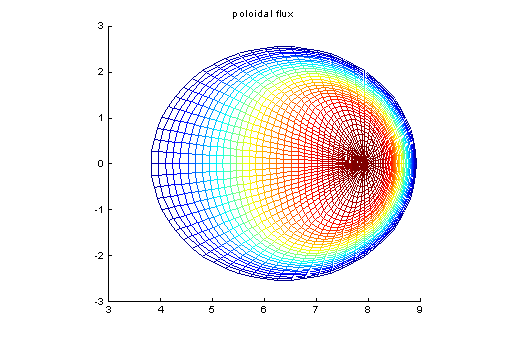
Fig.1 Magnetic surfaces adaptive grid:  , given , given  . .
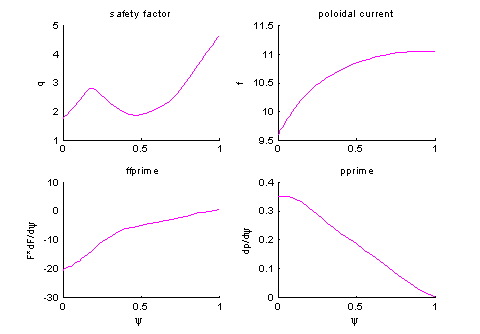
Fig.2 Plasma profiles versus normalized  : safety factor : safety factor  , poloidal current , poloidal current  , current density profile parameters , current density profile parameters  and and 
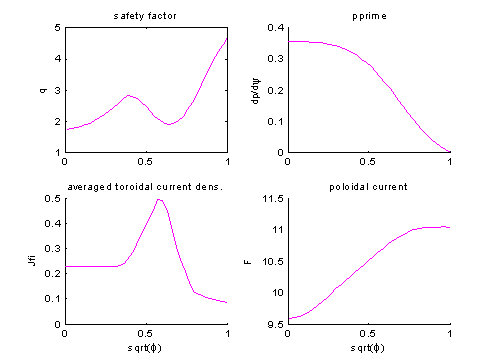
Fig.3. Plasma profiles versus
normalized  : safety factor : safety factor  , poloidal current , poloidal current  , current density profile parameters , current density profile parameters  and averaged and averaged  . .
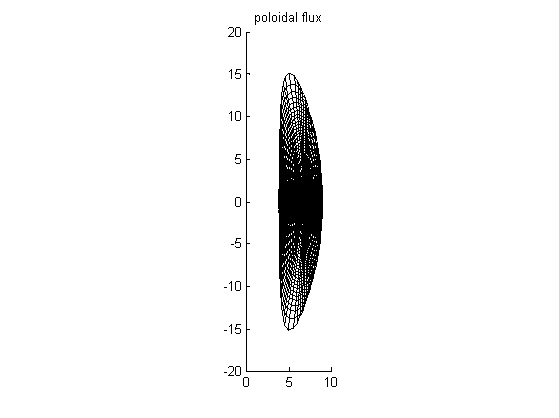
Fig.4. Magnetic surfaces
adaptive grid: plasma elongation 
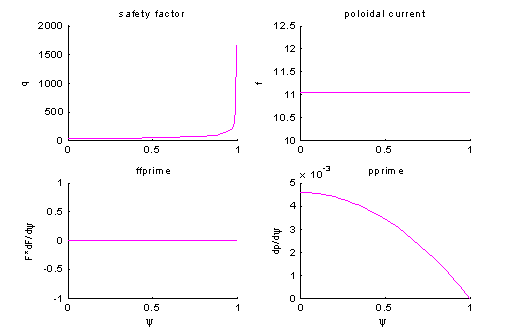
Fig.5. Plasma profiles versus
normalized  : safety factor : safety factor  , poloidal current , poloidal current  , current density profile parameters , current density profile parameters  and and  . .
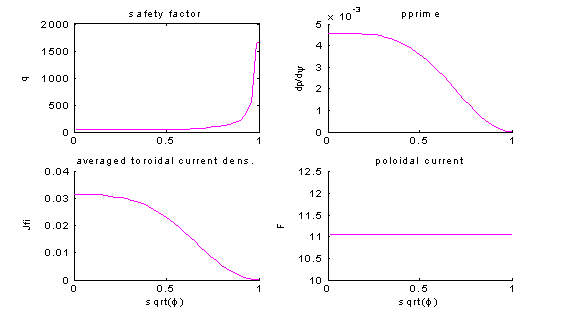
Fig.6. Plasma profiles versus
normalized  : safety factor : safety factor  , poloidal current , poloidal current  , current density profile parameters , current density profile parameters  and averaged and averaged  . .
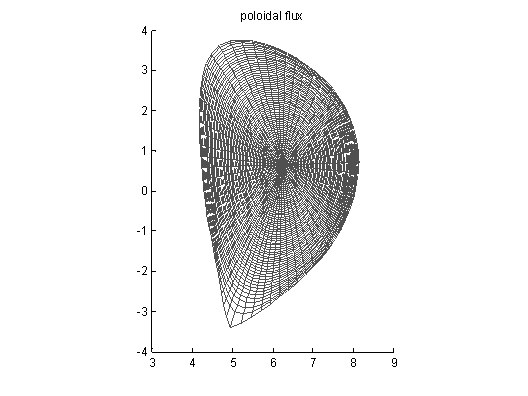
Fig.7. Magnetic
surfaces adaptive grid: diverted plasma.
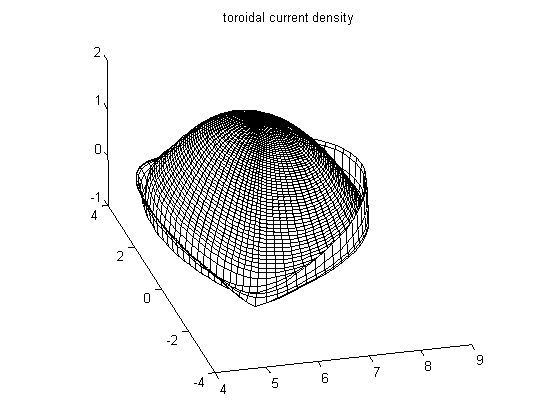
Fig.8. Plasma toroidal current density: diverted
plasma.
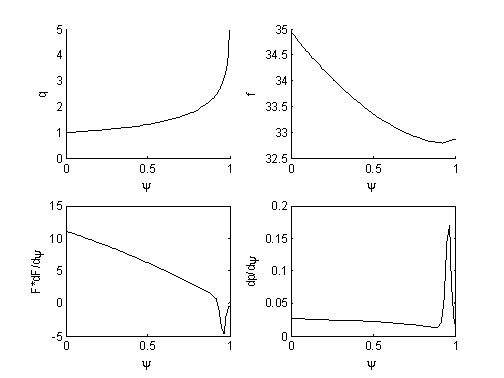
Fig.9. Plasma profiles versus
normalized  : safety factor : safety factor  , poloidal current , poloidal current  , current density profile parameters , current density profile parameters  and and  . .
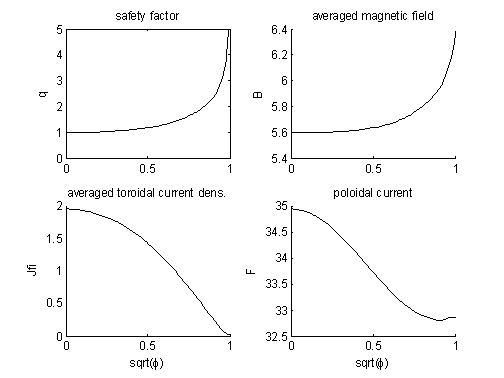
Fig.10. Plasma profiles versus
normalized  : safety factor : safety factor  , averaged magnetic field , averaged magnetic field  , averaged toroidal current density , averaged toroidal current density  , poloidal current , poloidal current  . .
7. References
[ 1 ] V.D.Shafranov, Reviews of Plasma Physics (Consultants Bureau, New York, 1966),
Vol. 2, p. 103.
[ 2 ] H.Grad and J.Hogan, Phys. Rev. Lett. 24, 1337 (1970).
[ 3 ] H.Grad, P.N.Hu and D.C.Stevens, Proc. Natl.
Acad. Sci. USA 72, 3789 (1975).
[ 4 ] L.E.Zakharov and V.D.Shafranov, Reviews of Plasma Physics (Consultants
Bureau, New York, 1981), Vol. 11, p. 153.
[ 5 ] R.R.Khairutdinov and V.E.Lukash, J. Comput.
Phys. 109, 193 (1993).
[ 6 ] L.Degtyarev, A.Martynov, S.Medevedev,
F.Troyon, L.Vilard and R.Gruber, Comput. Phys. Commun, 103, 10 (1997).
[ 7 ] S.A.Galkin, V.V.Drozdov, A.A.Ivanov,
S.Yu.Medvedev and Yu.Yu.Poshekhonov, General Atomic Report GA-A23045, May 1999.
[ 8 ] S.A.Galkin, A.A.Ivanov, S.Yu.Medvedev and
Yu.Yu.Poshekhonov, Nucl. Fusion 37,
No. 10, 1455 (1997).
[ 9 ] W.Feneberg and K.Lackner, Nucl. Fusion 13, 549 (1973).
[10] F.J.Helton and T.S.Wang, Nucl. Fusion 18, 1523 (1978).
[11] J.L.Lohnson, H.E.Dalhed, J.M.Green et al., J. Comput. Phys. 32, 212, (1979).
[12] J.P.Goedbloed, Comput. Phys. Commun, 24, 311 (1981).
[13] J.Blum, J.L.Foil and B.Thooris, Comput.
Phys. Commun. 24, 235 (1981).
[14] H.Lutjens, A.Bondesons and A.Roy, Comput.
Phys. Commun. 69, 287 (1992).
[15] J.DeLucia, S.C.Jardin and A.M.Todd, J.
Comput. Phys. 37, 183, (1980).
[16] K.M.Ling and S.C.Jardin, J. Comput. Phys. 58, 300, (1985).
[17] R.Gruber, R.Iacono and F.Troyon, J. Comput.
Phys. 73, 168, (1987).
[18] G.T.A.Huysmans, J.P.Goedbloed and W.Kerner,
in Proceedings CP90 Conference on Computational
Physics Proceedings (Word Scientific, Singapore, 1991), p. 371.
[19] B.Turkington, A.Lifschitz, A.Eydeland and
J.Spruck, J. Comput. Phys. 106, 269
(1993).
[20] G.O.Ludwig, Plasma Phys. Controlled Fusion 39, 2021 (1997).
[21] R.Albanese and F.Villone, Nucl. Fusion 38, 723 (1998).
[22] L.L.Lao, H.E.St.John, R.D.Stambaugh,
D.Stambaugh, A.G.Kellman and W.Pfeiffer, Nucl. Fusion 25, 1611 (1985).
[23] J.Blum, E.Lazzaro, J.O'Rourke, B.Keegan and
Y.Stephan, Nucl. Fusion 30, 1475
(1990).
[24] J.R.Ferron, M.L.Walker, L.L.Lao,
H.E.St.John, D.A.Humphreys and J.A.Leuer, Nucl. Fusion 38, 1055 (1997).
[25] L.LoDestro and L.D.Pearlstein, Phys. Plasmas
1, 90 (1994).
[26] J.F.Clark and D.J.Sigmar, Phys. Rev. Lett. 38, 70 (1977).
[27] S.P.Hirshman and S.C.Jardin, Phys. Fluids 22, 731, (1979).
[28] V.D.Khait, Sov. J. Plasma Phys. 6, 476 (1980).
[29] L.L.Lao, S.P.Hirshman and R.M.Wieland, Phys.
Fluids 24, 1431 (1981).
[30] L.L.Lao, Comput. Phys. Commun. 31, 201 (1984).
[31] P.N.Vabishevich, L.M.Degtyarev and
A.P.Favorski, Sov. J. Plasma Phys. 4,
554 (1978).
[32] L.M.Degtyarev and V.V.Drozdov, Comput. Phys.
Rep. 2, 341 (1985).
[33] L.M.Degtyarev and V.V.Drozdov, Int. J. Mod.
Phys. C 2, 30 (1991).
[34] S.Yu.Medvedev, L.Villard, L.M.Degtyarev,
A.A.Martynov, R.Gruber and F.Troyon, 20th EPS Conf. on Controlled
Fusion and Plasma Phys., Lisbon, Proc. Contrib. Papers, Vol. 17C, Part IV, 1279 (1993).
[35] V.V.Drozdov, The POLAR-2D-NW code, Private
coomunications.
[36] R.R.Khayrutdinov, J.B.Lister, V.E.Lukash and
J.P.Wainwright, Plasma Phys. Control. Fusion, 43, 321 (2001).
[37] J.-Y.Favez, R.R.Khayrutdinov, J.B.Lister,
and V.E.Lukash, Plasma Phys. Control. Fusion, 44, 171 (2002).
[38] ITER Final Design Report. Control System
Design and Assessment, Section 5.1.1 "Plasma Current, Position and Shape
Control", G45 FDR 1 10-70-13 R1.0, 2001.
[39] L.E.Zakharov and A.Pletzer, Phys. of Plasmas
6, No. 12, 4693 (1999).
[40] Ref. on the EFIT code
[41] IAEA-CN-94/CT/P-08, ITER Preprints,
INTERNATIONAL ATOMIC ENERGY AGENCY NINETEENTH FUSION ENERGY CONFERENCE, Lyon,
France, 14-19 October 2002.
[42] Samarsky A.A., Tishkin V.F., Favorsky A.P.,
et al. \\ Sov. J. Differential Equations
7, 1171 (1981).
[43] L.M.Degtyarev and V.V.Drozdov,
S.Yu.Medvedev. Equilibrium and stability
numerical modeling of toroidal plasma, USSR Academy Science Book,
M.V.Keldysh Institute of Applied Mathematics, Moscow 1989.
|
![]() and prescribed reverse
shear averaged current density profile
and prescribed reverse
shear averaged current density profile ![]() with circular plasma
boundary shape. Results of simulation are shown in Figs. 1-3. It is seen that
magnetic axes is shifted far away from the plasma geometrical center.
with circular plasma
boundary shape. Results of simulation are shown in Figs. 1-3. It is seen that
magnetic axes is shifted far away from the plasma geometrical center. ![]() is calculated. This
case demonstrates that code can reliably calculate quite exotic equilibrium
configuration without problems. Results of simulation are shown in Figs.
4-6.
is calculated. This
case demonstrates that code can reliably calculate quite exotic equilibrium
configuration without problems. Results of simulation are shown in Figs.
4-6. 
![]() , given
, given ![]() .
.
![]() : safety factor
: safety factor ![]() , poloidal current
, poloidal current ![]() , current density profile parameters
, current density profile parameters  and
and ![]()

![]() : safety factor
: safety factor ![]() , poloidal current
, poloidal current ![]() , current density profile parameters
, current density profile parameters ![]() and averaged
and averaged ![]() .
.
![]()

![]() : safety factor
: safety factor ![]() , poloidal current
, poloidal current ![]() , current density profile parameters
, current density profile parameters  and
and ![]() .
.
![]() : safety factor
: safety factor ![]() , poloidal current
, poloidal current ![]() , current density profile parameters
, current density profile parameters ![]() and averaged
and averaged ![]() .
.


![]() : safety factor
: safety factor ![]() , poloidal current
, poloidal current ![]() , current density profile parameters
, current density profile parameters  and
and ![]() .
.
![]() : safety factor
: safety factor ![]() , averaged magnetic field
, averaged magnetic field ![]() , averaged toroidal current density
, averaged toroidal current density ![]() , poloidal current
, poloidal current ![]() .
.









 .
. 



 ,
, ,
,


 ,
, ,
, ,
,


 ,
, ,
, 



 .
.




